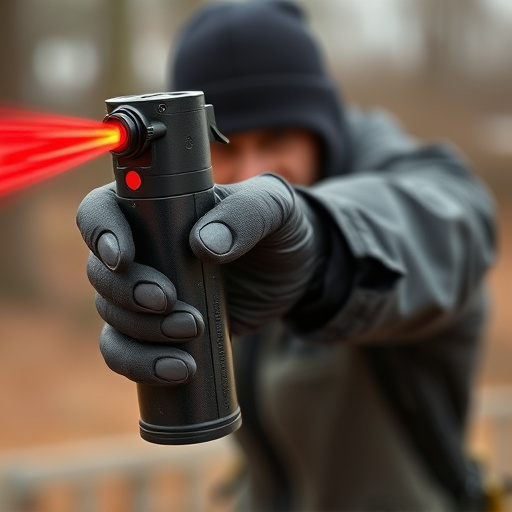Pepper spray is an effective, non-lethal defense against aggressive dogs, using capsaicin from chili peppers to irritate eyes and respiratory systems. When selecting a pepper spray for dog deterrence, choose products with higher capsaicin concentrations and specialized nozzles designed for targeting sensitive areas. Proper application involves maintaining safety, creating space, and aiming at the dog's face while using a sweeping motion. Legal considerations vary by region; understanding local laws regarding possession and use is crucial to avoid legal issues and ensure effective deployment as a last resort.
Personal safety is paramount when facing aggressive dogs, and pepper spray can be an effective defense mechanism. This article delves into the world of pepper spray as a deterrent against canine aggression. We’ll explore its composition, understanding its effectivity, and how to choose the right spray for your needs. Learn essential application techniques to use this tool responsibly within legal boundaries, ensuring both your safety and that of your loved ones when encountering aggressive dogs.
- Understanding Pepper Spray: Its Composition and Effectiveness Against Dogs
- Choosing the Right Pepper Spray for Personal Safety When Facing Canine Aggression
- Application Techniques: How to Use Pepper Spray Effectively During a Dog Encounter
- Legal Considerations and Responsible Ownership: Using Pepper Spray for Self-Defense Within Legal Boundaries
Understanding Pepper Spray: Its Composition and Effectiveness Against Dogs
Pepper spray, a powerful defense mechanism, has become an essential tool for personal safety, especially when encountering aggressive dogs. Its composition is designed to cause temporary disability by irritating the eyes and respiratory system. The active ingredient, capsaicin, is derived from chili peppers and is known for its potent irritant properties. When sprayed, it creates a burning sensation, leading to tears, coughing, and difficulty breathing. This reaction significantly reduces the dog’s ability to attack or chase its target.
The effectiveness of pepper spray against dogs is well-documented. It can be particularly useful in deterring unprovoked attacks or when dealing with larger breeds known for their strength and ferocity. The spray creates a protective barrier, allowing individuals to escape or summon help. Its non-lethal nature makes it a preferred option for self-defense, providing a safe way to defend against dog aggression while minimizing the risk of harm to both the individual and the animal.
Choosing the Right Pepper Spray for Personal Safety When Facing Canine Aggression
When considering personal safety against canine aggression, choosing the right pepper spray is paramount. Look for a product designed specifically to deter dogs, as these formulations often have higher capsaicin concentrations and specialized nozzles that can reach and irritate a dog’s eyes and nostrils—areas highly sensitive to pain. Pepper spray defense against dogs should also consider factors like range, ease of use, and weather resistance, ensuring it’s effective in various scenarios.
Additionally, understanding the legal implications of carrying pepper spray for self-defense is crucial. Different regions have varying regulations regarding the possession and use of such devices. Always check local laws to ensure compliance, as this not only prevents legal repercussions but also guarantees its effectiveness when needed most.
Application Techniques: How to Use Pepper Spray Effectively During a Dog Encounter
When facing an aggressive dog, knowing how to apply pepper spray effectively can be a crucial defense mechanism. Start by ensuring your safety and that of any companions; create space between you and the dog while maintaining eye contact. Aim for the face—the eyes, nose, and mouth—as these areas are highly sensitive. A good technique is to sweep your arm side-to-side in an arc, covering as much of the dog’s face as possible. This motion delivers a powerful spray that can temporarily incapacitate the canine, giving you time to retreat or defend yourself further.
Practice makes perfect; familiarize yourself with the spray’s range and wind patterns to optimize its effectiveness. Keep in mind that pepper spray is best used as a last resort when all other escape or de-escalation tactics have failed. Understanding how and when to deploy it during dog encounters can significantly enhance your personal safety, especially if you’re an avid hiker, runner, or pet owner navigating areas with potential canine hazards.
Legal Considerations and Responsible Ownership: Using Pepper Spray for Self-Defense Within Legal Boundaries
When considering pepper spray as a personal safety tool, especially for defending against dogs, it’s crucial to understand legal boundaries. Different jurisdictions have varying laws regarding the possession and use of pepper spray, so responsible ownership begins with knowing what is permitted in your area. Some regions allow citizens to carry pepper spray for self-defense purposes, while others restrict its use to law enforcement or require specific licensing.
Responsible ownership involves adhering to local regulations, ensuring proper storage, and understanding when it’s legal and safe to deploy. Using pepper spray for self-defense against dogs should only be considered as a last resort when other methods fail, and it must not be aimed at individuals or animals unrelated to an immediate threat. Familiarizing yourself with the legal implications of carrying and using pepper spray will help ensure you remain within the law while protecting yourself in potential dangerous situations involving dogs.
When faced with canine aggression, equipping yourself with knowledge and the right tools can make all the difference. Pepper spray, specifically designed as a defense against dogs, offers a powerful yet temporary solution. By understanding its composition, choosing the suitable type for your needs, learning proper application techniques, and staying within legal boundaries, you can enhance your personal safety during encounters with aggressive dogs. Remember, responsible ownership includes being aware of local laws and using pepper spray as a last resort to protect yourself.
